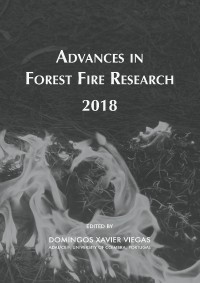Please use this identifier to cite or link to this item:
https://hdl.handle.net/10316.2/44587| DC Field | Value | Language |
|---|---|---|
| dc.contributor.author | Shen, Chen | |
| dc.contributor.author | Fletcher, Thomas H. | |
| dc.contributor.author | Weise, David R. | |
| dc.date.accessioned | 2018-11-09T14:20:58Z | |
| dc.date.accessioned | 2020-09-06T17:31:34Z | - |
| dc.date.available | 2018-11-09T14:20:58Z | |
| dc.date.available | 2020-09-06T17:31:34Z | - |
| dc.date.issued | 2018 | - |
| dc.identifier.isbn | 978-989-26-16-506 (PDF) | |
| dc.identifier.uri | https://hdl.handle.net/10316.2/44587 | - |
| dc.description.abstract | Current operational fire spread models are mostly based on experimental results from dead, low moisture fuel beds and thus do not perform well when modeling fire behavior in live shrubs. Although computational fluid dynamics (CFD) models predict more reliable combustion behavior, they have a high computational cost, large grid sizes for landscape-scale simulations, and oversimplified combustion within a shrub. There is a need for intermediate-scale shrub combustion models that describe better solid fuel combustion properties and shrub architecture, which may serve as sub-grid models for landscape fire spread simulations. A previously-developed semi-empirical shrub combustion model was improved and expanded to treat live chamise and big sagebrush. Fire spread in live chamise and big sagebrush shrubs was measured in an open-roofed wind tunnel at the Pacific Southwest Research Station in Riverside, CA, which was used as the basis to develop the current model. Wind speed was held constant at 1.4 m/s. Fuel segment placement was modeled by coupling a Lindenmayer systems (L-systems) approach with LiDAR scan data. Species specific correlations for physical properties and combustion characteristics of individual fuel element were developed from individual leaf combustion experiments with a flat-flame burner system. These were incorporate in this model to simulate individual leaf flames, whose combustion history were updated every time step and further checked in flame merging sub-model to group flames and propagate flames to neighboring leaves. Fire spread in the shrub was completed when the number of burning leaves reached a minimum threshold. Bulk density and local fuel density were found to be two major factors in shrub flame propagation. The modeling results included flame height above the shrub, fraction of shrub burned, burn time, etc. Modeling results compared well with measured time-dependent fire behavior in the wind tunnel. Fuel element placement in the semi-empirical shrub combustion model was improved when a combined L-systems and LiDAR approach was used to describe shrub architecture. This coupled architecture approach resulted in the most consistent and best predictions of combustion behavior for most experiments as compared to other random fuel element placement approaches. Variations in local fuel density affected flame spread more than the overall fuel bed density. Combustion temperature correction and species sensitive flame merging algorithm further improved the accuracy of modeling results. This model is an innovative approach to simulate shrub combustion via flame propagation at individual fuel element scale with a fairly low computational cost. | eng |
| dc.language.iso | eng | - |
| dc.publisher | Imprensa da Universidade de Coimbra | por |
| dc.relation.ispartof | http://hdl.handle.net/10316.2/44517 | por |
| dc.rights | open access | - |
| dc.subject | shrub combustion | eng |
| dc.subject | live shrubs | eng |
| dc.subject | wildland fire | eng |
| dc.subject | modeling | eng |
| dc.title | Semi-empirical fire spread model for chamise and big sagebrush shrubs with spatially-defined fuel elements and flames | por |
| dc.type | bookPart | por |
| uc.publication.firstPage | 637 | - |
| uc.publication.lastPage | 642 | - |
| uc.publication.location | Coimbra | por |
| dc.identifier.doi | 10.14195/978-989-26-16-506_70 | - |
| uc.publication.section | Chapter 3 - Fire Management | por |
| uc.publication.digCollection | PB | por |
| uc.publication.orderno | 70 | - |
| uc.publication.area | Ciências da Engenharia e Tecnologias | por |
| uc.publication.bookTitle | Advances in forest fire research 2018 | - |
| uc.publication.manifest | https://dl.uc.pt/json/iiif/10316.2/44587/204235/manifest?manifest=/json/iiif/10316.2/44587/204235/manifest | - |
| uc.publication.thumbnail | https://dl.uc.pt/retrieve/11059057 | - |
| uc.publication.parentItemId | 55072 | - |
| uc.itemId | 68853 | - |
| item.grantfulltext | open | - |
| item.fulltext | With Fulltext | - |
| Appears in Collections: | Advances in forest fire research 2018 | |
Files in This Item:
| File | Description | Size | Format | |
|---|---|---|---|---|
| semi-empirical_fire_spread_model.pdf | 939.58 kB | Adobe PDF |  |
Items in DSpace are protected by copyright, with all rights reserved, unless otherwise indicated.
